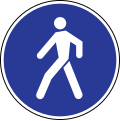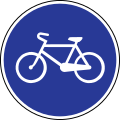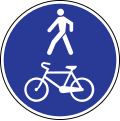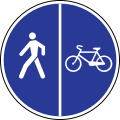In Nederland, we use designated as: “intended for certain road users by the traffic authority, by rules of traffic or the owner.” We require the intention to be visible on the ground, preferably by signage, but sometimes it may be tied to other visible things, such as a kerb and elevation.
Traffic regulations are always tied to visible elements; traffic signs have their meaning assigned to them by law, and the same holds true for other visible attributes. If not, they are not valid and we don’t tag it, except where a private landowner uses their own signage on their own land and announces it in a clear way. If they do that, then the signage is again backed up by law: private owners are allowed by law to do that and people have to comply.
I think access rules are always tied to something visible (how else could a traveler know?) and to the regulations stating which access follows from the visible ground truth.
For a footway, foot=designated and motor_vehicle=no are implied by highway=footway, and bicycle=no is the default. If cycling is allowed on the footway bicycle=yes can be added. This way, we think the Dutch situation is mapped in a way that worldwide routers can handle, without having to know specific country dependant signage, markings and rules, and without massively tagging the obvious.
For a cycleway, bicycle=designated is implied by highway=cycleway. Our default foot access on cycleway is foot=yes. If pedestrians are explicitly excluded from the cycleway, we tag foot=no.
(BTW To my surprise, the worldwide access defaults table gives foot=no for foot access. I think that is a mistake, I think most of the world in principle allows foot access to cycleways, and I suspect most routers accept cycleways in their foot profiles.)
Mandatory use is another thing. Many Dutch cycleways are mandatory for cyclists, and many cycleways are not. Mandatory means, if there is a road next to it, cyclists must use the cycleway. We do not tag mandatory access on the cycleway itself, mandatory cycleways are certainly designated cycleways, so designated is the access. Then on the road we tag bicycle=use_sidepath (bicycle=no is also still used a lot), so that expresses that the cycleway should be used.
Again, this way we think the Dutch situation is mapped in a way that worldwide routers can handle, without having to know specific country dependant signage, markings and rules, and without massively tagging the obvious.
A path which is designated to both bicycles and pedestrians, we tag as highway=path & bicycle=designated & foot=designated, possibly with segregated=yes|no. This combination does occur in Nederland, but it is unusual. Far more common is a sidewalk attached to a cycleway, which usually is tagged as sidewalk=right|left on the cycleway.
(BTW some tools have been known to add segregated=yes to cycleways where sidewalk=* was already tagged. This is redundant. If found, data users should treat sidewalk=* as further refinement of the kind of segregation, and ignore it.)
 -
-  -
-  -
-  -
-  (this could have text like “except bicycles” or “only on weekends”, etc.)
(this could have text like “except bicycles” or “only on weekends”, etc.)